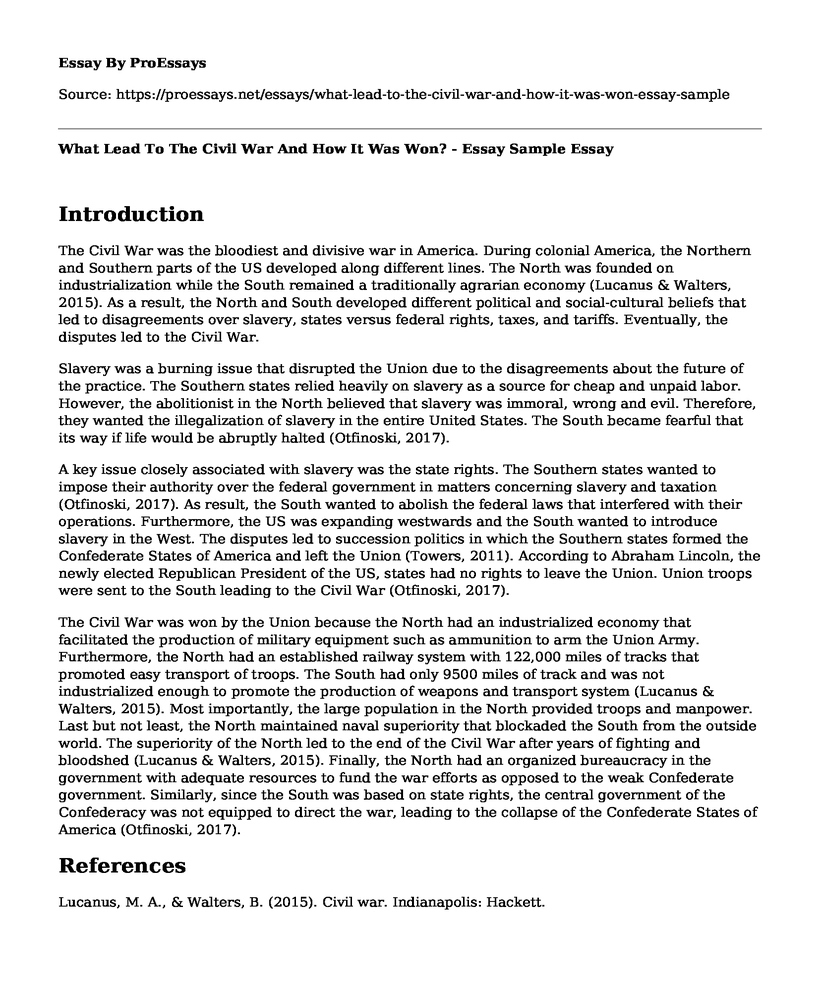Introduction
The Civil War was the bloodiest and divisive war in America. During colonial America, the Northern and Southern parts of the US developed along different lines. The North was founded on industrialization while the South remained a traditionally agrarian economy (Lucanus & Walters, 2015). As a result, the North and South developed different political and social-cultural beliefs that led to disagreements over slavery, states versus federal rights, taxes, and tariffs. Eventually, the disputes led to the Civil War.
Slavery was a burning issue that disrupted the Union due to the disagreements about the future of the practice. The Southern states relied heavily on slavery as a source for cheap and unpaid labor. However, the abolitionist in the North believed that slavery was immoral, wrong and evil. Therefore, they wanted the illegalization of slavery in the entire United States. The South became fearful that its way if life would be abruptly halted (Otfinoski, 2017).
A key issue closely associated with slavery was the state rights. The Southern states wanted to impose their authority over the federal government in matters concerning slavery and taxation (Otfinoski, 2017). As result, the South wanted to abolish the federal laws that interfered with their operations. Furthermore, the US was expanding westwards and the South wanted to introduce slavery in the West. The disputes led to succession politics in which the Southern states formed the Confederate States of America and left the Union (Towers, 2011). According to Abraham Lincoln, the newly elected Republican President of the US, states had no rights to leave the Union. Union troops were sent to the South leading to the Civil War (Otfinoski, 2017).
The Civil War was won by the Union because the North had an industrialized economy that facilitated the production of military equipment such as ammunition to arm the Union Army. Furthermore, the North had an established railway system with 122,000 miles of tracks that promoted easy transport of troops. The South had only 9500 miles of track and was not industrialized enough to promote the production of weapons and transport system (Lucanus & Walters, 2015). Most importantly, the large population in the North provided troops and manpower. Last but not least, the North maintained naval superiority that blockaded the South from the outside world. The superiority of the North led to the end of the Civil War after years of fighting and bloodshed (Lucanus & Walters, 2015). Finally, the North had an organized bureaucracy in the government with adequate resources to fund the war efforts as opposed to the weak Confederate government. Similarly, since the South was based on state rights, the central government of the Confederacy was not equipped to direct the war, leading to the collapse of the Confederate States of America (Otfinoski, 2017).
References
Lucanus, M. A., & Walters, B. (2015). Civil war. Indianapolis: Hackett.
Otfinoski, S. (2017). The Civil War. New York, NY: Scholastic.
Towers, F. (2011). Disunion! The Coming of the American Civil War, 1789- 1859 (review). Civil War History, 57(3), 272-273.
Cite this page
What Lead To The Civil War And How It Was Won? - Essay Sample. (2022, Jun 16). Retrieved from https://proessays.net/essays/what-lead-to-the-civil-war-and-how-it-was-won-essay-sample
If you are the original author of this essay and no longer wish to have it published on the ProEssays website, please click below to request its removal:
- Comparative Essay Sample: Two Articles on Food Stamps
- Paper Example on Historical Events and Historical Figures
- Religion, Morals, and Slavery Essay
- Assignment Example on Cold War History
- Factors That Led to American Victory in WW2 Essay Example
- Essay Sample on The Cherokee Indians
- Essay Example on Exploring Political Science Trends Post WW2: UN Mission for Unity







